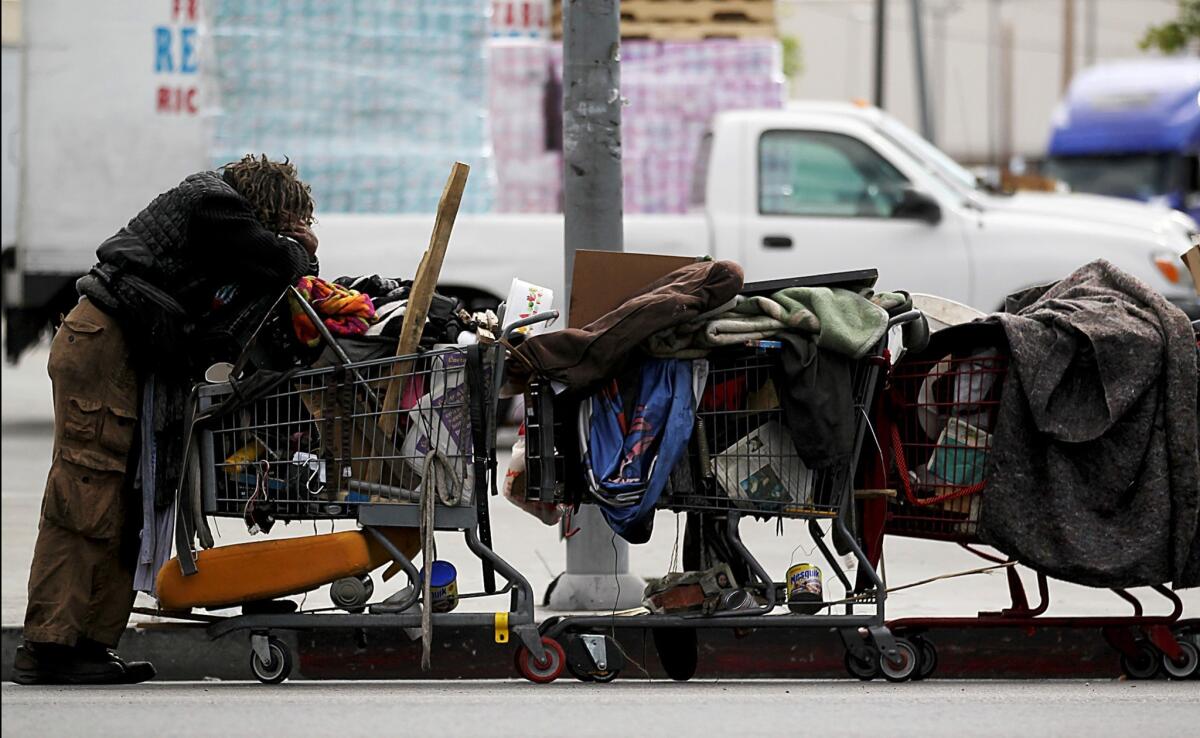Why a one-size solution to L.A.’s homelessness crisis is destined to fail

- Share via
Homelessness is the Rorschach test of humanitarian crises: We all see what we want to see. Some identify the core problem as the lack of affordable housing or inadequate rent control laws. Others fault the lack of quality treatment for people struggling with mental illness, addiction, rampant economic inequality or the plague of mass incarceration.
As someone who spends his days providing services to our homeless neighbors, I can tell you every one of those things plays a role. There are as many reasons for homelessness as there are people sleeping on sidewalks. And that means we need a wide range of approaches to solving the problem, aimed at addressing the needs of individuals. We simply can’t force all homeless people into a relatively narrow set of solutions.
In recent years, the focus has been primarily on building more permanent supportive housing to get people off the streets and provide them with services that will keep them housed. That approach is absolutely essential, but it can’t be the only one.
Lately, Sacramento Mayor Darryl Steinberg and others have talked about the need also for more temporary shelter beds. This is another step in the right direction. But we’re still not thinking broadly enough.
We also need to expand transitional housing options, which provide indispensable, on-site mental health services, job training and life-skills education to help formerly homeless people be better neighbors when they move into permanent supportive housing. We need to fund alternative, and often less costly, types of housing, including shared homes, rooms rented from friends or family, and single-room-occupancy dwellings.
And our planning needs to acknowledge an uncomfortable fact: A large swath of the unsheltered population is resistant to services. There are many Angelenos living on the streets who simply refuse to accept the help.
Today, those who can’t be convinced by outreach workers to seek services can’t be forced to accept help unless they are considered an immediate danger to themselves or others. That’s true even for those struggling with mental illness or addiction. It is perfectly permissible to refuse assistance and stay on the streets.
That adds up to an untenable system. As this paper recently reported, L.A. County is on track to seeing 1,000 homeless people die this year. We need to rethink how we balance individual rights with the dangers of living on the streets.
One thing this will require is being honest about the risky approach of the recent Mitchell settlement. That legal agreement between homeless advocates and the city allows people living on the sidewalks in the skid row area to keep most of their belongings with them. This has caused pest infestation and the spread of disease as well as blocked public right-of-ways.
No one wants to take away anyone’s right to protect personal property, but do we really think that allowing someone to keep an unlimited array of possessions on the sidewalk solves anything? The real problem is that people are left to live on the sidewalks, not whether or not they can keep unlimited stuff with them. We need to be devoting all of our best efforts to ending homelessness entirely.
And as we evaluate how to do that, we have to confront another uncomfortable truth: In the interest of preserving the civil rights of those who are homeless, we’re often allowing them to spiral further downward. In the interest of not criminalizing homelessness, we tend to avoid taking more affirmative steps and enforcing basic societal norms, ultimately leaving many to live in filth and subject themselves to further victimization.
A recent measure in San Francisco expanded that city’s conservatorship law to allow public agencies to more easily exert guardianship over people who are suffering from severe mental illness or are addicted to drugs or alcohol. It’s a highly controversial step. Yet, if we’re serious about helping service-resistant individuals who can’t necessarily help themselves, such a measure should be seriously considered.
And we shouldn’t stop there. We have to look at increased law enforcement for drug dealers and criminal gangs who prey on the homeless. We have to invest in mental health residential treatment facilities. We have to lead a broader effort to reunite homeless people with their family members and friends. In every context, it’s clear that one of the prescriptions for success is a caring support network.
There are those who say that there’s no such thing as a service-resistant individual — just people we have yet to reach. But the consequence of this approach is that the longer it takes to reach a person, the greater the likelihood the person will spiral downward and die on the streets. This is not an intellectual exercise in civil liberties. This is life and death.
I’ve also listened repeatedly to the argument that we can’t consider compelling resistant women and men to accept treatment and services until we have enough spots to house all of them. But the methods we have been using have completely failed to get us ahead of a growing crisis. We need to consider acting on a few uncomfortable ideas, in the name of truly addressing the deepest crisis facing the city, county and state today.
Kevin Murray is president and CEO of the Weingart Center Assn. Previously, he served in both houses of the state Legislature.
More to Read
A cure for the common opinion
Get thought-provoking perspectives with our weekly newsletter.
You may occasionally receive promotional content from the Los Angeles Times.









